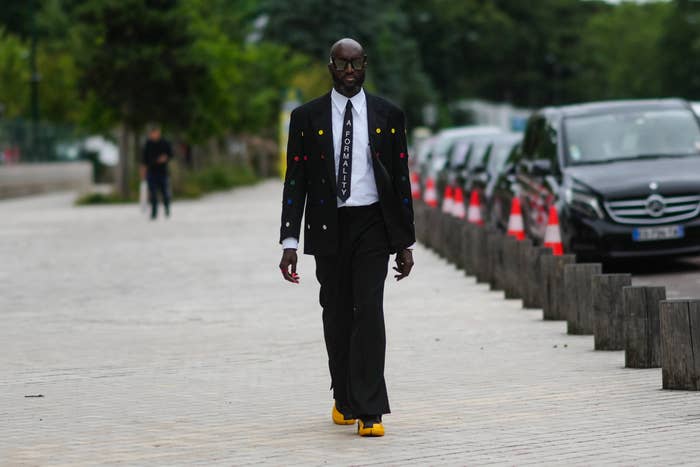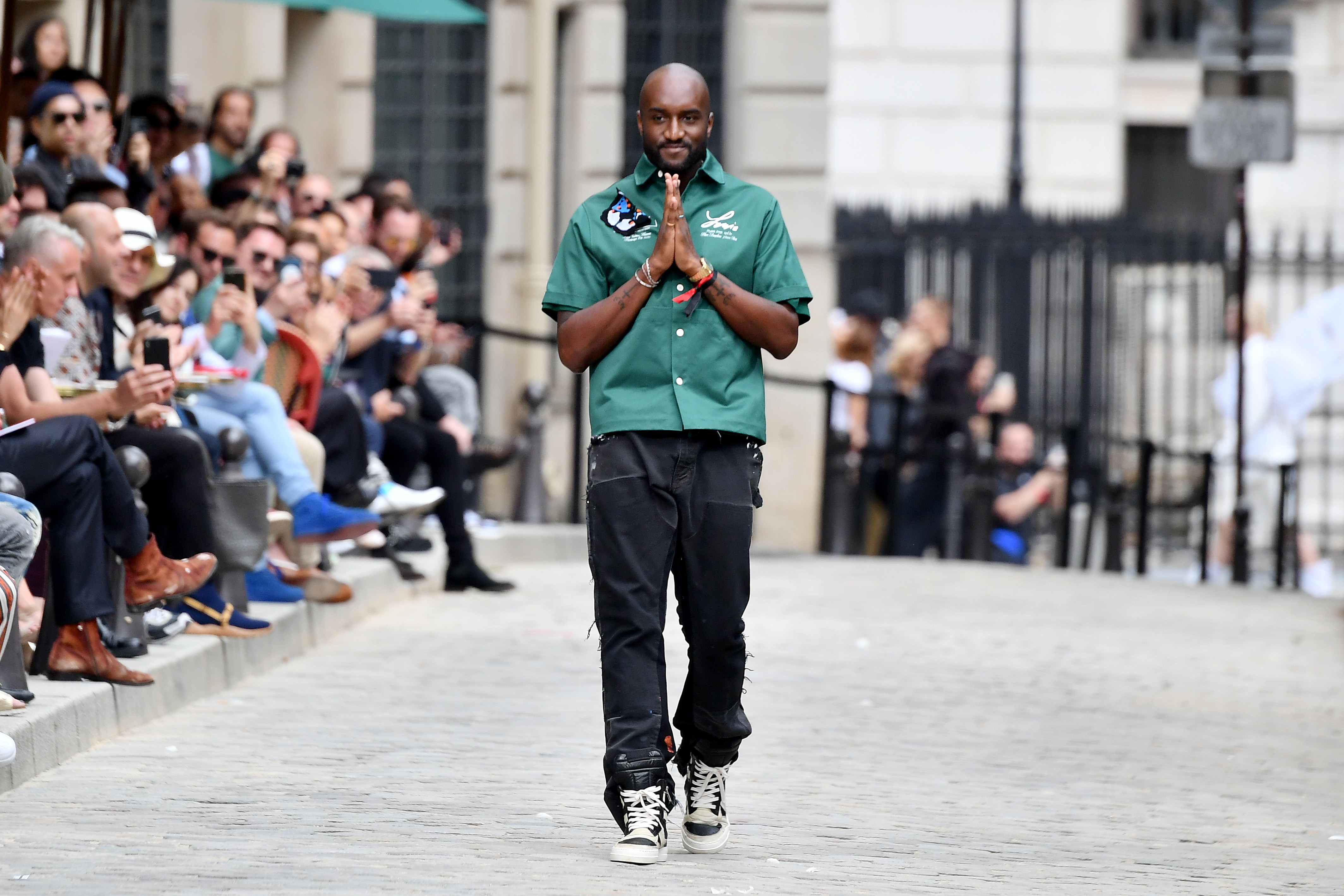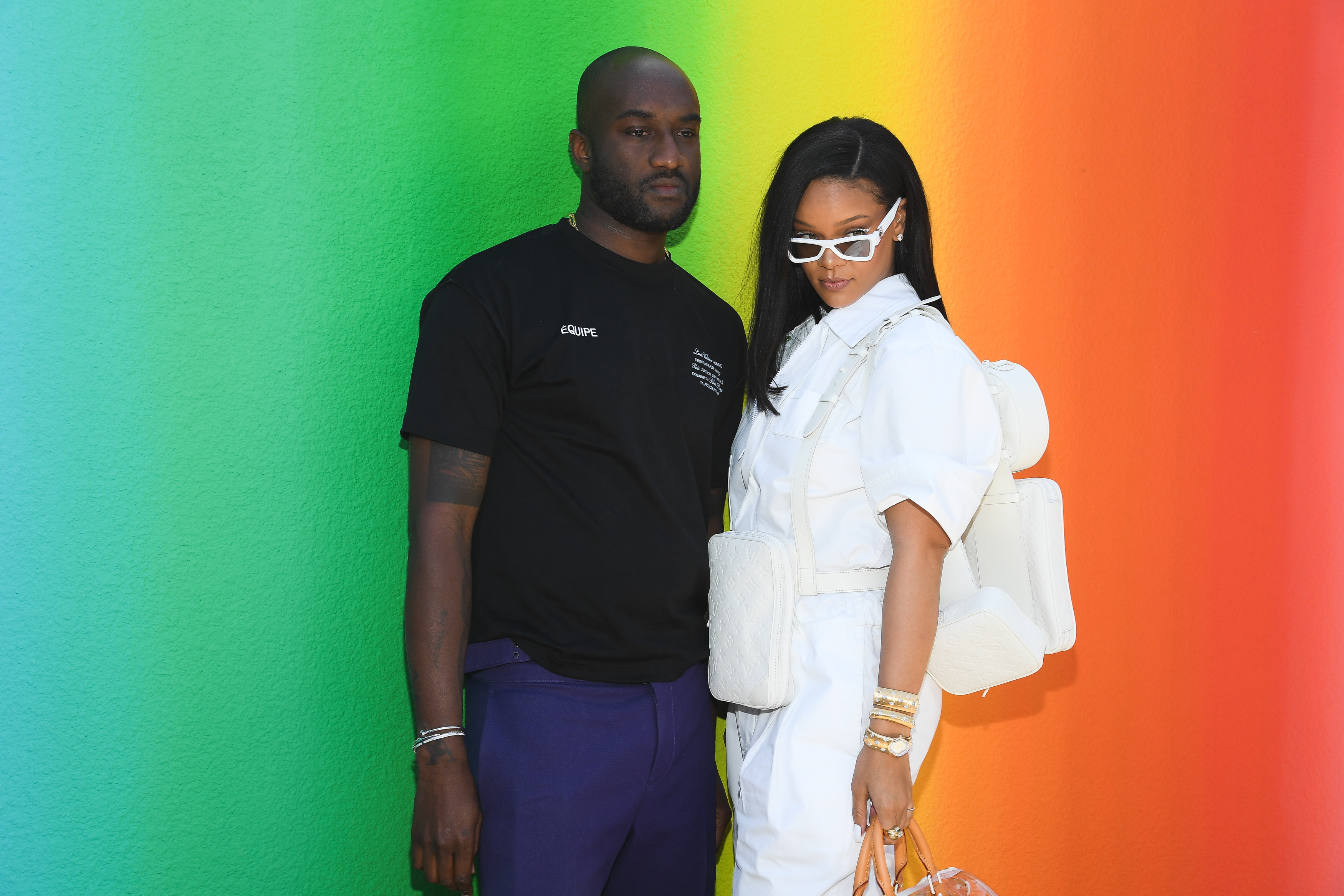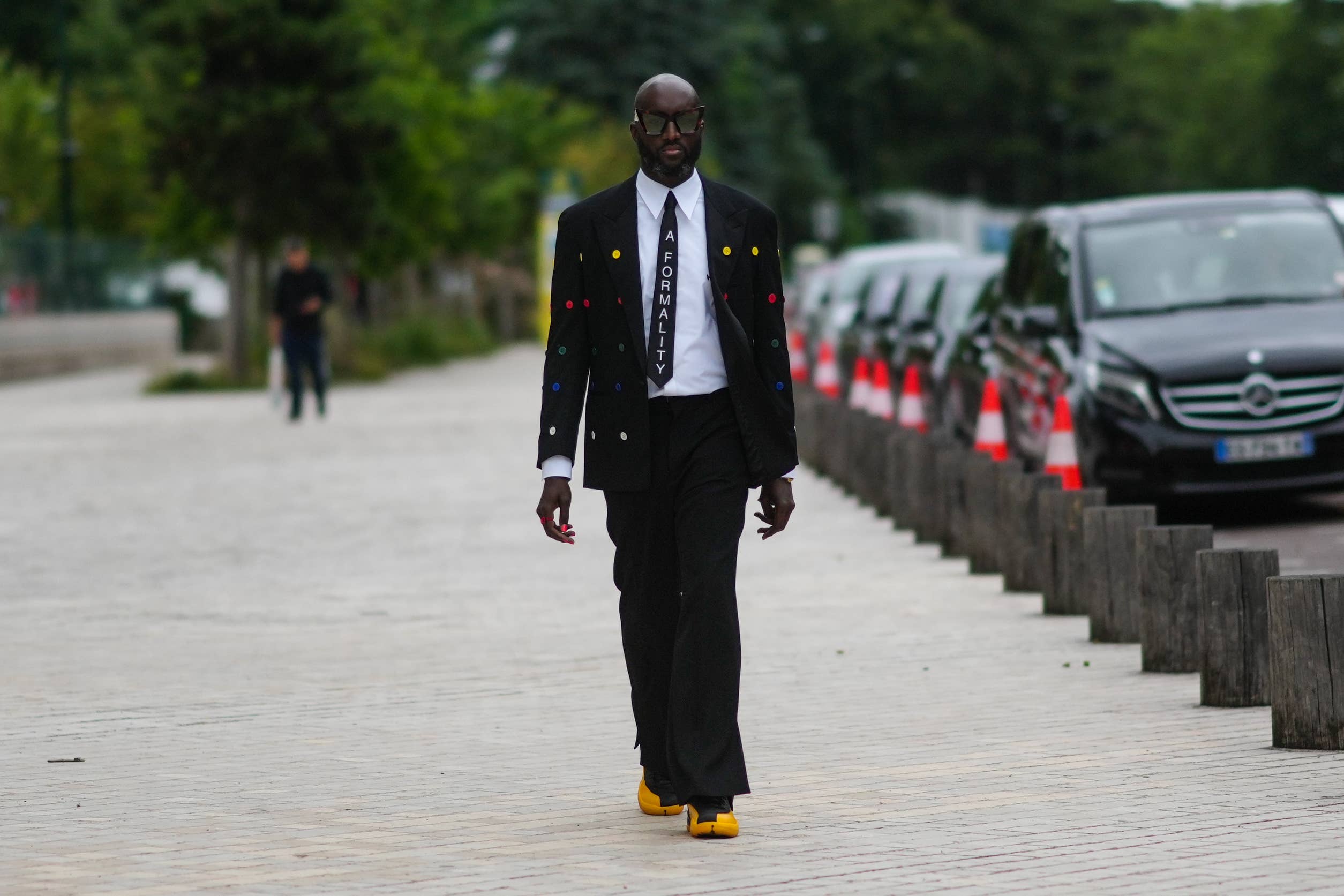
Who would have thought that the tall Black gentleman wearing canary yellow sneakers, red framed sunglasses, a shiny Moncler vest, and a Jil Sander by Raf Simons shirt (with a bowtie) would become the artistic director of Louis Vuitton Men’s?
In 2009 Virgil Abloh, who would land that position almost a decade later, was photographed with Kanye West, Don C, Fonzworth Bentley, Taz Arnold and Chris Julian by Tommy Ton at Paris Fashion Week. This picture, which was taken outside of the Comme des Garçons Homme show, signified a time when Paris Fashion Week looked very different from how it looks today. Remember that meme? And these gentlemen knew they deserved to be a part of it.
When Abloh spoke to Complex, almost exactly 10 years after the photograph was taken, he said the picture captured a “proper tourism.” They weren’t supposed to be there, but they were, and dressed to the nines to ensure that they were seen, heard, and acknowledged. That’s commonly how Black people utilize clothes. They take pieces that weren’t made for them and make them their own, lending them a whole new interpretation that is oftentimes swaggier than the original version. “The agenda was really to let our clothes speak for us,” Abloh told GQ.
At that point Abloh said he couldn’t get a Louis Vuitton show invite and described going into the store as “difficult.” But he remained optimistic. “I believe that art and good nature can actually change the world. I refuse to believe the opposite,” Abloh told Complex. “I didn’t think I would be the head of Louis Vuitton then but I knew it was possible.”
View this video on YouTube
There’s a certain amount of blind faith that Black artists and designers have to have in any industry, but particularly the luxury fashion industry in Europe. The barrier to entry is expensive, racism is a thing, and the pipeline for designers usually doesn’t include people like Abloh, a first-generation Ghanaian-American from Illinois who didn’t attend Parsons, the Fashion Institute of Technology, Central Saint Martins, or Antwerp’s Royal Academy of Fine Arts, design schools that have produced some of today’s most revered fashion designers. Abloh studied civil engineering and architecture and was reared under the school of Kanye West.
When Tommy Ton took that picture, Abloh was working for DONDA, West’s creative agency. He had designed the cover for “808s & Heartbreak,” West’s fourth album, with Willo Perron, and he was on a journey with West to learn as much as they could about making luxury clothes. They consulted the late Central Saint Martins’ professor Louise Wilson to see if they should actually go to fashion school—she said they knew more than her students and called them crazy. They interned at Fendi for half a year making $500 a month. They worked together to change how luxury perceived them, but Black culture has always been synonymous with luxury, whether the industry wanted to recognize it or not. Abloh comes from a lineage of designers like Dapper Dan, who was creating luxury sportswear using other brands’ logos out of his atelier in Harlem; Russell Simmons and Kimora Lee Simmons, who asserted that hip-hop was an aspirational lifestyle with Phat Farm and Baby Phat; Sean “Puffy” Combs, who wanted Sean John to be more than a streetwear brand so he presented at New York Fashion Week and campaigned for a prestigious CFDA Award, which he won in 2004; Pharrell Williams, who was wearing giant purple crocodile Hermès Birkin bags with his Billionaire Boys Club line that he designed with Nigo, the founder of BAPE; and later Shayne Oliver, whose proposition for Hood By Air helped fuel the luxury streetwear category that still exists today.
While West and Abloh wanted to get inside of the luxury system and present their ideas, they weren’t the only Black artists and designers who created a presence for themselves in Europe. In 1988 Patrick Kelly became the first American designer to be admitted into the Chambre Syndicale du Prêt-à-Porter des Couturiers et des Créateurs de Mode, France’s designer association. Edward Buchanan joined Bottega Veneta in 1995 and built its ready-to-wear collection. Ozwald Boateng was named the creative director of Givenchy men’s in 2003. And later Olivier Rousteing became creative director at Balmain in 2011. And there were Black designers working in the background like Andre Walker, who worked on his own line and consulted for Kim Jones and Marc Jacobs at Louis Vuitton, and Felicia Farrar, who assisted designers like Azzedine Alaia, Herve Leger, and Ocimar Versolato of Lanvin during the ‘80s.

But Abloh was a bit different. Oftentimes the industry flattens Black designers into being one thing. You either make streetwear like Walker Wear, Karl Kani, Cross Colours, and Fubu, or you follow the traditional path to be a formally trained designer like Willi Smith of WilliWear. But Abloh was an amalgamation of the designers who came before him and many other things. He frequently spoke about his reference points that included artists like Marcel Duchamp and Caravaggio, New York-based brands like Supreme and Alife, music ranging from techno to hip-hop, and buildings designed by Rem Koolhaas. He helped raise certain questions like why can’t subcultures be considered high art? Why is luxury a label only for heritage European brands? And why aren’t my ideas valid in these spaces?
Abloh started making clothes with a very streetwear spirit. With Pyrex Vision, which is named after the glasses drug dealers use to cook crack, he screen printed Rugby Ralph Lauren flannels, which retailed for $79.95, with Pyrex and the number 23, after Michael Jordan, and sold them for $550. He was merging different American dreams and upcharging the same way luxury labels have for years. During a talk at Columbia University in 2017, Abloh said that the flannels touched on an idea he frequently heard while growing up in Chicago that only drug dealers and athletes made it out. Pyrex Vision, which was co-signed by ASAP Rocky, was hot, but once the glass cookware company sent a cease and desist letter, he transitioned to Off-White, named after the gray space between black and white. He wanted Off-White to be recognized as a luxury brand, so he started working with the New Guards Group, a manufacturer and distributor based in Milan that also produced Hood by Air. He was insistent about positioning it as a designer label. He told GQ: “I was adamant: ‘This isn’t a streetwear brand. This isn’t a contemporary brand. This is designer, just the same way that X, Y, Z are designer, where you say their name and it carries this whole esteem and emotion to it.’ And a lot of people asked, ‘Why do you do women’s? And why are you selling things on this floor and not that floor?’”
It’s a very similar conversation designers like Karl Kani and Kimora Lee Simmons had with buyers who wanted to keep their pieces on the “urban” floor during the ‘90s and early 2000s. But Abloh learned from the past and understood how the industry worked and utilized tools those designers didn’t have, like Instagram. He accentuated the line with easy to recognize symbols like diagonal stripes, quotation marks, and orange zip ties. Some would say that’s not design, but these signatures spoke to the consumer’s desire to be seen and to belong, a psychology that Abloh didn’t invent—it’s at the root of fashion consumption—but he understood it and used it to his advantage.
Positioning and alignment helps us reorient how we perceive things, and Abloh knew that in order to transcend the “Black streetwear designer” label he would need to show up in different spaces and assert his work as art. He gave lectures at Columbia University and Harvard, he exhibited his furniture in galleries, and collected his work for a midcareer “Figures of Speech” exhibition that opened at the Museum of Contemporary Art in Chicago in 2019. When his collaboration with Nike, The 10, released in 2017, he held Off Campus workshops and talks, bringing customers in on his process in a way that wasn’t typical of Nike. Abloh’s efforts had a dual purpose. He was giving “young” people the tools and teaching “older” people the value of his ideas. “I’m responsible to the youth, but I’m also trying to educate that upper layer of fashion that is looking at your Instagram and taking your ideas,” Abloh said at his Columbia lecture.
His efforts worked. Abloh was named the artistic director of Louis Vuitton men’s in 2018. “In a way, all of my output has been to make a compelling case for me to take on a role such as this,” Mr. Abloh told the New York Times. “I think of it as kind of the ultimate collaboration.” It was a historic moment that signalled a changing of the guard, but also upset some people who thought Abloh spent more time copying than presenting new ideas. Over his career Abloh received multiple copying allegations. Recently April Walker of Walker Wear sued Off-White for trademark infringement and Walter Van Beirendonck accused Abloh of copying. Raf Simons told GQ Style that Off-White isn’t original. In the same interview he referenced Demna Gvasalia, formerly of Vetements but currently at Balenciaga, who also slightly changes designs that already exist, but Simons went on to say: “I don’t think you can compare him [Gvasalia] at all to the guy from Off-White. So I cannot talk about these people in the same way.” But Abloh always called himself a maker who abides by Duchamp’s 3 percent rule, which states that you only need to change something by 3 percent in order for it to feel recognizable and completely new. That philosophy seemed like less of a way to justify what he did as a designer and more of a way for the industry to explore what “new” ideas they were actually presenting. In 2012 Abloh tweeted: “Design is the freshest scam. Quote me on that one.”
However, it’s always been about more than the clothes with Abloh. “Fashion is kinda a joke,” he told The Cut. “I don’t get too bogged down in the clothes. For me, it’s one big art project, just a canvas to show that fashion should have a brand which has someone behind it who cares about different contexts. Social things.” But if we think about commercial viability, which Abloh needed to remain a part of these spaces, presenting what’s familiar is the name of the game. I often wonder if a Central Saint Martins degree would have worked for Abloh’s trajectory. Would that have been enough for Michael Burke, the chief executive officer at Louis Vuitton, to deem him as credible for the position? I often think about why Rihanna, a global pop star, is the only Black woman to lead a house at LVMH. I don’t know the reason, but a popular Chris Rock bit comes to mind. Seems like today it’s not enough to be a Black designer with a design degree to land a creative director position at LVMH. You must be a global pop star or have strong affiliations to one, like Abloh did.

View this video on YouTube
Abloh didn’t lament the struggles that happened behind closed doors like West did. Instead he spoke subtly through his shows. Like when he named his Fall 2016 Off-White women’s show “You’re obviously in the wrong place,” a quote from the film “Pretty Woman.” But it wasn’t until his Fall 2020 Off-White men’s show that took place in January 2020, which we now know occurred after his cancer diagnosis, that I sensed a sullenness and a message that wasn’t so subtle. The show opened with no music, just the sound of Cartier Williams tap dancing on the hardwood floor of the Les Salles du Carrousel. Williams started out behind a sheer curtain that blurred his image before exiting and tap dancing around the perimeter of the room wearing a graphic T-shirt that read, “I support young Black businesses.” It was one of Abloh’s best shows, with models wearing relaxed suits with holes, intarsia graphic knits, and the perfect leather trousers and jackets. Williams looked tired and energetic at the same time as he moved throughout the space. Abloh told Vogue, “It’s more acceptable for him and I to say we’re basketball players than this form of dance.” The tap dancing fit into Abloh’s overall thoughts about the boxes Black people are put in, but as I watched the show I wondered if Abloh felt like he was tirelessly tap dancing for an audience.
A few days after his death, Louis Vuitton posted a short video featuring a young Black boy with cornrows biking through Miami by himself, gliding around a cylindrical parking structure, crossing highways, hanging out on the beach, and exploring a shipping yard. He was experiencing his surroundings with abandon before hopping into a red LV branded hot air balloon and floating into the sky. The video, which teased what would be Abloh’s final show in Miami on Tuesday, depicted Black boyhood, a consistent throughline in Abloh’s work, and imagination. “This is my invitation to move forward together with awareness, hope and determination. You are witnessing unapologetic Black imagination on display. If you made it this far, thank you for your time,” Abloh wrote in a manifesto that accompanied the show notes for his final show.
A lot of Black people are creative because they have to be. They have to create worlds for themselves because they don’t exist; will their dreams into fruition; and teach the world that their vision is valid. That’s what Abloh did throughout his career. He tapped into a childlike wonder and worked tirelessly to thrive in a system that wasn’t built for him. Abloh’s optimism helped redefine what luxury is and who should have access to it. He pushed heavy doors ajar. I hope the industry keeps them open.




